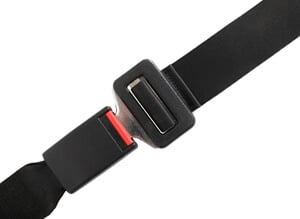Defective Seat Belts Cause Injuries in Collisions and Rollovers

Seat belts save lives, but defectively designed seat belts can be deadly. A person who is involved in a car crash may be wearing a seat belt but still experience severe or fatal injuries. If this is the case, the person may have been a victim of a defective seat belt or a defective crashworthiness system.
A seat belt with a defective design does not adequately protect the occupant who is wearing it, causing injuries sustained during a car crash or rollover to be much worse than they should have been. Defective seat belt systems may also not function effectively in specific crash conditions.
Examples of Seat Belt Defect Injury Cases
Passive Restraint Seat Belt Failure
Passive restraint seat belts can still be found in some vehicles, especially in older ones. These are typically door-mounted seat belts that automatically move into positions meant to protect passengers. But passive restraint belts often require passengers to take the extra step to secure the lap portion of the belt. During a crash, these designs can be very dangerous. Common injuries observed in passive belt cases include neck Injuries, cervical fractures, abdominal injuries, lacerated liver, and ejection from the vehicle.
If someone was injured by a passive restraint seat belt, they should contact a product liability lawyer.
False Latching and Seat Belt Inertial Unlatching
Inertial unlatching occurs—often during rollover crashes—when a seat belt latch breaks open during a crash. Upon impact, the seat belt latch breaks open, causing the person wearing the belt to fly forward, rather than remaining securely in their seat. Inertial unlatching may occur if the seat belt latch was inadequately built or designed.
In the case of “false latching”, the person wearing the seat belt was led to believe that they secured the seat belt fully, especially if they heard a click upon fastening. False latching can often be attributed to defective latch design.
Ripped Seat Belt During a Crash
Similar to inertial unlatching, a seat belt that rips during a crash will not adequately secure a person in the vehicle, causing them to fly forward or be severely jolted during the crash.
Lap-Belt Injuries
Lap belts that do not have an over-the-shoulder strap can pose serious risks of spinal injuries during a crash. Lap belts can also be the root cause of severe injuries during a vehicle collision since forces of restraint are concentrated across the lap.
Lap belts are typically found in the back and middle seats of a vehicle, especially in older cars. Though 3-point seat belts that go across the lap and over the shoulder have been mandated for all driver and passenger seats in recent years, seat belts can still be the cause of injuries to passengers if not worn correctly or if the shoulder strap is removed from across the body. It is important to wear the seatbelt as intended to minimize the risks of lap-belt injuries.
Seat Belt Spool-Out Cases
Spool-out occurs when the seat belt flies out of the retractor during a collision or rollover, rather than stopping short to prevent the passenger from flying forward. In a spool-out event, the seat belt will offer no protection to the person during the crash or rollover. Every seat belt should have a locking mechanism that secures the passenger during a crash or sudden impact.
Contacting a Car Accident Attorney for Defective Seat belt Cases
If you or a loved one were hurt in a car accident, and think it may have possibly been due to a defective seat belt or another defective car product, call the auto product liability lawyers at The Rothenberg Law Firm Accident and Injury Lawyers at 1-800-624-8888, or fill out the form for a free and confidential case evaluation to see if you have a case. The Rothenberg Law Firm Accident and Injury Lawyers can provide the experienced legal help you need.
Timing is important, because statutes of limitations affect how long you have to file a claim.







